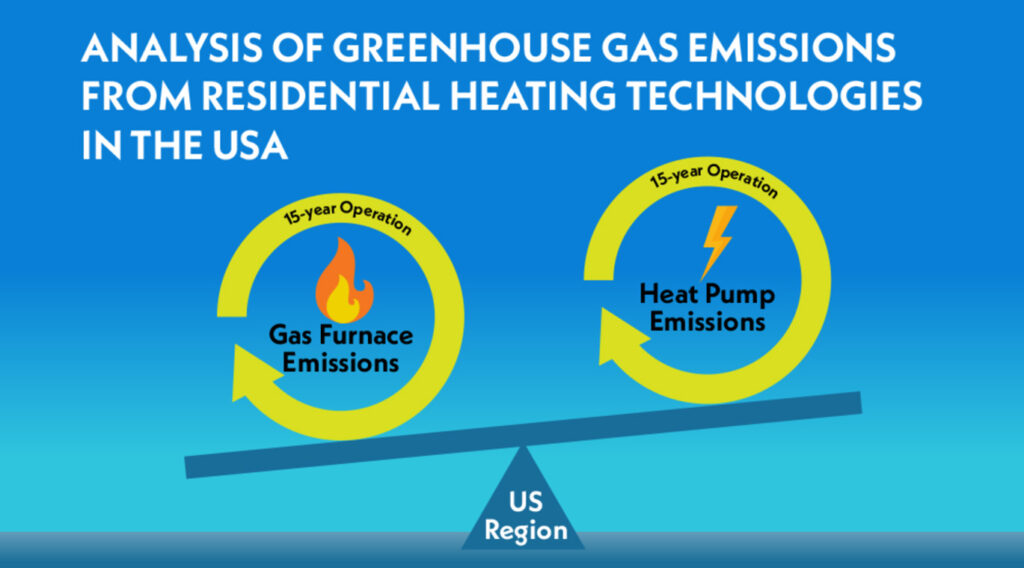
Residential energy use is responsible for about 20% of total greenhouse gas (GHG) emissions in the US. Growing housing stock and continued use of fossil fuels to heat homes is making it more challenging to meet emissions reduction targets set forth by various states. As the electric grid gets decarbonized, policymakers are considering electrification (converting natural gas appliances to electric heat pumps in new and existing construction) as a means of reducing GHG emissions from natural gas combustion and leakage. Although electric heat pumps do not have on-site combustion, there are emissions associated with electricity generation as well as with refrigerant leaks.
WCEC has conducted studies to understand and predict changes in GHG emissions resulting from replacement of natural gas furnaces with heat pumps in a variety of cities and building types.
Current Work
Our current work aims to inform policymakers about the GHG emission impacts of heat pump deployment in residential homes. Electric heat pumps eliminate direct burning of fossil fuels in homes but result in indirect emissions due to fossil fuels burned for electricity production. Salient features of our work involve:
- Residential building models from Pacific Northwest National Laboratory – single family, two stories
- Construction year of 2006
- Construction year of 2018
- Equipment simulated
- Variable speed heat pump with electric strip heat (HPSF = 10)
- Natural gas furnace (AFUE = 96%)
- Emissions were forecasted over a 15-year operating life, with installation dates ranging from 2022 to 2036 in two-year increments
- TMY3 weather data used for 99 cities spanning across six regions across the US
- Emission sources analyzed:
- Long-run marginal emissions from electric grid predicted by National Renewable Energy Laboratory (Cambium 2022-2050)
- Emissions from natural gas combustion in homes
- Natural gas leak during production for electricity generation and furnace heat
- Methane and refrigerant leaks behind the meter
This work provided the first detailed analysis comparing the expected 15-year operational GHG emission impacts (2022-2050) from a natural gas furnace and a heat pump for heating a single-family residential home in six regions across the US. Our methodology considered the time varying nature of the electricity generation mix by simulating the hourly heating loads of the house in various climate zones. The population weighted US average results show emission reductions for a heat pump over a furnace to be 38-53% for carbon dioxide, 53-67% for 20-Year global warming potential (GWP), and 44-60% for 100-Year GWP, with reductions increasing over time. The impact of fugitive emissions from the furnace is significantly higher than that of the heat pump. While more energy efficient construction reduces overall emissions for both heating types, the forecasted percent emission reduction for replacement of a gas furnace with heat pump was not impacted by changes in home construction parameters. The results from this study show that residential heat pump installation, in place of natural gas furnaces will significantly reduce operational GHG emissions under a wide range of geographic and climatic conditions.
Path Forward
Additional work is underway to expand our analysis to office buildings and include Variable Refrigerant Flow (VRF) as this technology is gaining popularity.
If you are interested in receiving a copy of our data, please contact us at: wcec@ucdavis.edu
Previous Work
In a previous project, WCEC simulated the change in annual CO2 emissions resulting from replacement of residential natural gas furnaces with four different heat pumps in the contiguous 48 states of the US. The study looked at short run marginal emissions from the grid to predict and compare annual emissions. The following parameters were analyzed:
- Single-speed all electric heat pump (electric resistance backup heat)
- Variable-speed all electric heat pump (electric resistance backup heat)
- Single-speed dual-fuel heat pump (natural gas backup heat)
- Variable-speed dual-fuel heat pump (natural gas backup heat)
- Historical weather and marginal emissions rates from 2019 were simulated for over 200 locations across the US. Each location simulated represented a unique combination of climate zone and electric utility territory.
Progress/Results:
When compared to a natural gas furnace, the:
- Single-speed all electric heat pump reduced CO2 emissions in 4 states
- Variable-speed all electric heat pump reduced CO2 emissions in 8 states
- Single-speed dual-fuel heat pump reduced CO2 emissions in 9 states
- Variable-speed dual-fuel heat pump reduced CO2 emissions in 15 states
RESOURCES
PUBLICATIONS
- Greenhouse gas emission forecasts for electrification of space heating in residential homes in the US (2022 | Academic Journal)
- Analysis of Greenhouse Gas Emissions from Residential Heating Technologies in the USA (2020 | Technical Report)
- Analysis of NOx Emissions from Hybrid Heating Technologies in California (2020 | Technical Report)
SEMINARS AND WEBINARS
- WEBINAR: Analysis of Greenhouse Gas Emissions from Residential Heating Technologies in the USA
(2020 | Webinar| Webinar Slides)
Sponsor: NRDC, Trane

